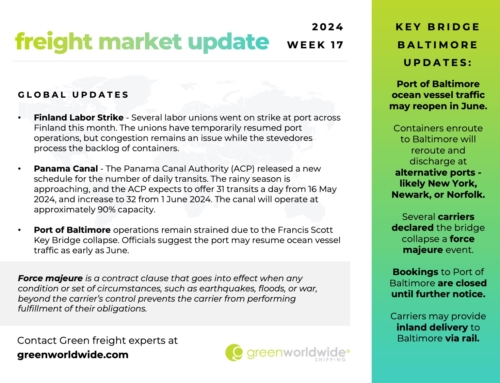POTENTIAL UPS STRIKE
The pending strike by United Parcel Service (UPS) Teamsters is causing widespread concern throughout global supply chains. As negotiations between UPS and the Teamsters stagnate, businesses worldwide are preparing for potential disruptions to shipping and logistics services.
The potential August 1, 2023, strike may create bottlenecks and delays in the shipment of goods. The impact will reverberate across industries, impacting sectors such as e-commerce, automotive, healthcare, and beyond.
UPS stated that they have begun training non-union employees to mitigate service disruptions should the Teamsters take labor action.
“We have a responsibility as an essential service provider to take steps to help ensure we can deliver our customers’ packages if the Teamsters choose to strike. Over the coming weeks, many of our U.S. employees will participate in training that would help them safely serve our customers if there is a labor disruption.”
UPS Statement
ALTERNATE CARRIERS
The United States Postal Service (USPS), global parcel companies, and regional carriers are ramping up their operations to meet the potential surge in demand. However, the volume of packages UPS handles daily may be challenging for other carriers to quickly integrate into their existing capacity. On global courier company stated, “in the event of a market disruption, no carrier can absorb all UPS volume.”
Average Daily Package Deliveries
UPS 24.3 million
USPS 23.8 million
FedEx 9.9 million
STRATEGIES FOR SHIPPERS
A range of options are available for business to mitigate disruptions to their supply chain should UPS Teamsters strike on August 1.
Collaboration and Partnership: Partner with a freight forwarding company that maintains a reliable and diverse carrier network. A freight forwarder will leverage relationships within their network to mitigate supply chain disruption by using alternate carriers, transportation modes, and trade routes.
Warehousing and Inventory Control: A key strategy to mitigate shipping disruptions is utilizing warehousing and inventory management. Stockpiling inventory in a secure warehouse offers businesses a safety net to sustain operations during periods of uncertainty. Proximity to key markets and implementing agile inventory management practices can help optimize supply and demand fluctuations.
Leverage Technology: Advancements in technology, including data analytics and real-time tracking systems, offer businesses enhanced visibility and efficiency in supply chain management. By leveraging these tools, companies can optimize processes, reduce bottlenecks, and respond quickly to supply chain changes.
Businesses must be proactive to mitigate potential supply chain disruptions. With the pending UPS strike, port labor stoppage in British Columbia, constrained ocean carrier capacity, and blank sailings ahead of season, shippers should be evaluating their trade lanes, modes, and alternate shipping solutions to prevent disruptions in their supply chains.
Collaboration with a freight forwarder, using warehouses to stockpile inventory, and leveraging technology will enhance supply chain visibility and efficiency. While potential supply chain disruptions like the pending UPS strike persist, businesses that adopt these strategies will be better equipped to navigate supply chain challenges, minimize disruptions, and maintain their commitments to customers.
NEED HELP WITH SHIPMENTS?
Contact [email protected] to speak with Green’s freight experts.
Stay up-to-date on freight news with Green’s Weekly Freight Market Update by following us on Facebook, Instagram, and LinkedIn. For continuous updates, make sure to check out our website at greenworldwide.com.






